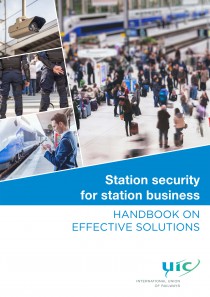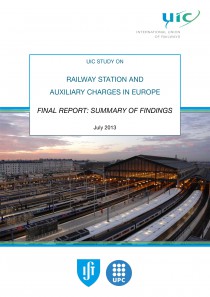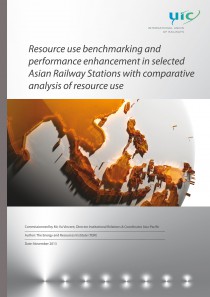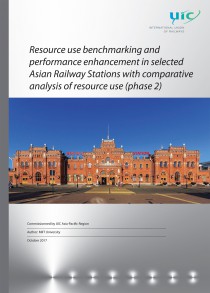Passenger Railway Stations
Whether for short or long distances, for regional, mass transit or high-speed travel, the transport of passengers by rail has a bright outlook. Among all the factors needed for the development of rail passenger transport (technology, marketing, ticketing, financing, etc.), the common point for rail companies, customers and society is railway stations.
Station Managers Global Group (SMGG)
Chair: Fabrice Morenon, SNCF
Vice-Chair: Paul Van Doninck, Jernhusen
The Station Managers Global Group aims to facilitate the exchange of best practices between actors and experts from around the world, to organise events, to launch studies and to standardise interoperability subjects. It is an incubator for new projects relating to stations.
Through the SMGG, UIC and its members are working to broaden the scope of railway station activities in order to offer greater added value for customers and cities.
To raise the awareness of station profitability, both in terms of experience and management, SMGG members took the decision to restructure the entire sector by creating Plenary sessions, a Steering Committee and four new technical working groups. This new sector structure will help members in their daily life, as well as enhance collaboration with other UIC Passenger Department sectors, such as the PASSAGE Group (for PRM issues), Intercity and High-Speed Committee (ICHSC), Commuter and Regional Train Services (CRTS) and the UIC Fundamental Values Department – Sustainability Unit and the UIC Rolling Stock Department – Infrastructure Sector.
This collaboration will establish very strong and positive future outcomes which will help members during their transition phase from simple train stations to sustainable and digitalised assets.
Strategic Axes and Objectives
The strategic vision is set up by the Plenary session of the SMGG and then reinforced by the technical support of the working groups: Design, Facility Management and Operation, Retail and Commercial Affairs, and Small Stations.
First priorities:
- Covid-19 analyses and the ‘New Normal’
- Restoration of confidence and solving Covid-19 issues at train stations to guarantee efficient service and safety
- Impact on retail business and development of resiliency
- Promotion of train stations as intermodal hubs
- Sustainability development in terms of train station buildings (energy consumption)
- Digital transformation of stations and the data commercial aspect
Objectives:
- Reduce the technical gap (in terms of IRS production) to other sectors
- Increase the quality of existing Technical Guidelines/IRS
- Increase the number and quality of studies driven by the Sector
- Increase the visibility of the Station Sector Network during international events
- Increase the expertise, knowledge and know-how of members
- Make the UIC nextstation Conference the priority event for railway station issues and integrate the subjects of the working groups
- Cooperate with other stakeholders
- Increase cooperation and exchange of knowledge on key station management issues
Station and Urban Design Working Group
Chair: Christophe Chevalier, AREP
Vice-Chair: David Hughes, Irish Rail
The foundation of an efficient train station depends on the system and smooth management of the asset supported by the design. Driven by a broad panel of different experts such as architects, station managers, structural engineers, landscapers and sustainable developers, the Station and Urban Design Working Group rethinks the way to build a station: a station as a rail asset, but also as a component of the city’s infrastructure and part of the entire urban mobility network.
However, the question of existing buildings is a very important issue, as heritage stations do not, for the most part, completely fulfil the requirements of passengers, station managers and sustainable development. Consequently, the challenge for the upcoming year will be the transition of train stations into a new digitalised and green model appropriate for regional expectations (responsive material, energy consumption, passive house, intermodality, urban integration, etc.)
Facility Management and Operation Working Group
Chair: David Handera, Amtrak
Vice-Chair: Stéphane Bolduc, VIA Rail Canada
This working group has been set up to provide a platform for station managers to communicate, exchange best practices, ask questions and carry out common projects. Digitalisation of buildings will significantly facilitate the management and maintenance of these specific assets. Close collaboration with the Rail System Department – Operation Sector is vital to achieve this. Digitalisation will offer a new perspective on existing station management, for example, the predictive maintenance made possible by big data is a revolution and will decrease the cost of station operation. The group also focuses on the experience of passengers and station users (vertical mobility equipment, outsourcing management, etc.), as the creation of a safe atmosphere is important due to the high degree of social interaction within a small space. The group’s objective is clear: provide better support for the management of railway stations across the world, in every season and for specific events.
Retail and Commercial Affairs Working Group
Chair: Ulrik Harms-Bauer, DSB
Vice-Chair: Maite Teresa Escolano Meba, ADIF
Covid-19 has had a considerable global impact on the rail sector and retail. With the dramatic decrease of rail passengers, retail and commercial activity at train stations almost completely stopped.
As a result and following the creation of this dedicated group, it is time to address this issue by developing new short- and long-term approaches to enhance the customer experience via new rail and non-rail related services.
Our retail and commercial experts will push into a new way of thinking, for example, by developing new types of advertising campaigns via social media, extending the scope of tenants’ profiles and attracting city services to commuter train stations.
Small Stations Working Group
Chair: Arthur Fojud, PKP/S.A
Vice-Chair: Robert Jordan, Amtrak
Before any projects could be set up, it was necessary to provide a common definition and specify the requirements for improving the full life cycle of small stations in terms of planning, construction, maintenance, demolition or refurbishment. Small stations have a huge impact on railway operation. With their low passenger rates, keeping small stations open creates many issues for infrastructure managers, but is economically and socially vital for small cities. Our panel of experts must find a balance to create resilience for every category of station size. At the same time, the Small Stations group is a wonderful platform for trialling initiatives and new ideas, as small stations have similar priorities to big stations (passenger and customer experience, asset management, costs, building life cycle, maintenance, etc.). Transition phases can be easily achieved in small stations which will generate experience and knowledge for bigger projects related to big stations.
UIC contact
For any further information please contact: Clément Gautier
UIC leaflets & IRS – International Railway Solutions
Leaflet 140 - Accessibility to stations in Europe
The purpose of the leaflet is to define a uniform framework governing the design of European stations to ensure consistency in the measures taken to facilitate access for the mobility-impaired. Participating establishments will form a stations network facilitating the mobility of people in Europe and making train travel more attractive. These stations may be referred to as “accessible stations”, provided that they meet the accessibility criteria laid down in the leaflet.
Account should also be taken of those people for whom travel is difficult owing to their circumstances, such as individuals accompanied by young children or loaded down with shopping bags, parcels or luggage.
The leaflet addresses aspects affecting accessibility and the standards governing achievement thereof. It also defines the “accessible stations” concept.
The body of the leaflet comprises a compilation of sketches and diagrams setting out the standards to be met by equipment and facilities. These form the cornerstone of an accessible station and serve as a benchmark. The technical standards given in the leaflet are recommendations to complement rather than supersede national standards.
The application of fundamental standards should take on board the special requirements affecting railway operations to guarantee safety and order. It should also take on board the objectives pursued by carriers and passenger terminal managers as customer-driven service companies. It is important to draw the attention of carriers and passenger terminal managers to customer requirements in terms of cleanliness and safety.
Leaflet 145 – Recommendations for the organisation of assistance services for persons with reduced mobility
This leaflet has been prepared by the Passenger Services Group – PASSAGE – responsible for topics and projects relating to persons with reduced mobility. It relates closely to Leaflet 140 drafted by the SMGG. It describes the process of delivering assistance to persons with reduced mobility where autonomous, barrier-free access to train services is not available. It offers recommendations for assistance delivery and communication flows between the stakeholders involved. The leaflet describes best practice and the steps being taken by those involved in the PASSAGE project to fulfil their obligations in respect of European passenger rights legislation.
Leaflet 180 – Classification of rail passenger stations
UIC Leaflet 180 provides a methodology for classification of railway stations according to criteria developed by the UIC working group on stations: the Station Manager Global Group (SMGG).
IRS 10181 – User information in railway stations
Passengers should have access to useful information and details of their routes in stations. These elements constitute the information chain, which includes every means of communication in the station: wayfinding, timetable screens, sound broadcasting system, information kiosk, maps, internet, mobile phone, etc.
This leaflet is about wayfinding – what it is for, how it is installed and implemented, and all the elements it comprises. A structural component of the information and orientation chain, wayfinding is a core service offered to passengers. It reflects a station or network’s image and identity. This is why wayfinding should always be consistent and rigorous in its application.
The leaflet describes the principles of wayfinding systems and provides instructions on how to operationalise such systems in order to inform and direct passengers. These instructions should be applied in and around stations. They should also be applied where existing wayfinding systems need to be modified: changes to wayfinding layout, stations under construction, etc.
National rules and standards should be observed.
The leaflet does not concern the areas of responsibility covered by the Highway Code. For guidelines covering safety equipment, such as emergency exits, etc., the applicable legal regulations and norms should be observed.
Handbooks
The research also offers conclusions on the close interconnection between resource use and the newly implemented concept of the “smart station”, underlining the links between the digitalisation process, environmental issues and enhancement of resource use efficiency in rail station and terminal operation. In particular, the study underlines the importance of system solutions for resource savings for various rail operations (client-focussed operation of stations and the transportation process, necessity to develop complex plans for resource management in stations, etc.). The report also offers information on tools for conducting resource-focussed surveys in railway stations.



